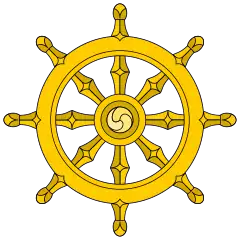Ushnisha
The ushnisha (Sanskrit: उष्णीष, IAST: uṣṇīṣa) is a three-dimensional oval at the top of the head of the Buddha.

| Part of a series on |
| Buddhism |
|---|
 |
|
Description
The Ushnisha is the thirty-second of the 32 major marks of the Buddha. The thirty-second of these is that the Buddha has a fleshy or cranial protuberance at the top of his head. Later sets elaborate that this is covered with hairs that curl in the direction of the sun.
Later on a second definition of Ushnisha was added, which was a flame that ascends from the middle of this protuberance.
Representation
The first representations of the Buddha in the 1st century CE in the Greco-Buddhist art of Gandhara also represent him with a topknot, rather than just a cranial knob. It is thought that the interpretation of the ushnisha as a supernatural cranial protuberance happened at a later date, as the representation of the topknot became more symbolic and its original meaning was lost.[1]
Origins
We have witnessed Ushnisha being an important feature of any Buddha statues and images, but there is no actual evidences which can give us a clear picture of whether Buddha had the top knot over his head. This is because when we study about Buddha in ancient books, it is clearly mentioned that Buddha had a shaven head. There is also one event mentioned in the text book where a hunter while out on a hunt encounters Gautama Buddha (prince of Lumbini) in a different attire than that a prince should had. The hunter is mentioned as giving up hunting for the day, after seeing the shaven man in the middle of the jungle, considering it to be a bad omen.[2]
The Boddhisattva-Cakravartin in Early Buddhism
In Early Buddhism, the uṣṇīṣa was represented differently. The Mahāvastu (1.259f) and the Divyāvadāna, as well as the Theravadin Milindapañha, describe the marks of the cakravartin, an idealised world-ruler: uṣṇīṣa or patka turban, chhatra parasol, "horn jewel" or vajra, whisk and sandals. These were the marks of the kshatriya.[3]
The plastic art of early Mahayana Buddhism in Mathura presents bodhisattvas in a form called uṣṇīṣin "wearing a turban/hair binding", wielding the mudras for "nonviolent cakravartin rule".[3]
See also
- Uṣṇīṣa Vijaya Dhāraṇī Sūtra : – via Wikisource.
References
- Mario Bussagli, L'art du Gandhara
- "Origin of Ushnisha".
- Falk, Harry, "Small-Scale Buddhism" in Voegeli, François; Eltschinger, Vincent; Candotti, Maria Piera; Diaconescu, Bogdan; Kulkarni, Malhar, eds. (2012). Devadattīyam : Johannes Bronkhorst felicitation volume. Bern: Peter Lang. ISBN 9783034306829., p. 495